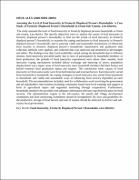| dc.contributor.author | Oruk, Alex | |
| dc.date.accessioned | 2018-12-04T07:16:22Z | |
| dc.date.available | 2018-12-04T07:16:22Z | |
| dc.date.issued | 2008 | |
| dc.identifier.citation | Oruk, A. (2008). Assessing the Level of Food Insecurity in Formerly Displaced Person’s Households: A Case Study of Formerly Displaced Person’s Households in Orum Sub-County, Lira District. Uganda Martyrs University, Nkozi: Uganda Martyrs University. | en_US |
| dc.identifier.uri | http://hdl.handle.net/20.500.12280/1182 | |
| dc.description.abstract | ORUK ALEX (2008-M092-20094)
Assessing the Level of Food Insecurity in Formerly Displaced Person’s Households: A Case Study of Formerly Displaced Person’s Households in Orum Sub-County, Lira District.
The study assessed the level of food insecurity in formerly displaced persons households in Orum sub-county, Lira district. The specific objectives were to: analyse the causes of food insecurity in formerly displaced person‟s households; to find out the extent of food insecurity in formerly displaced person‟s households; to examine the coping mechanisms to food insecurity in formerly displaced person‟s households; and to generate viable and sustainable mechanisms of enhancing food security in formerly displaced person‟s households. Quantitative and qualitative data collection methods were applied, and collected data was analysed and presented in percentages and tables. The findings were that; food availability varied among the households due to different reasons; food insecurity prevailed partly due to lack of participation by household members in food production; the periods of food insecurity experienced were above three months; food insecurity coping mechanisms included labour exchange and battering of assets; population displacement was a major cause of food insecurity since household members fled their homes and lacked essential food production inputs and support. The conclusions were: causes of food insecurity in Orum sub-county were from both internal and external factors; food insecurity varied from household to household; the coping strategies to food insecurity also varied from household to household; and viable and sustainable ways of enhancing food security depended on each household. The recommendations included; need for collaborative work involving the government and all stakeholders; interventions including community-based farm level trainings and support in form of agricultural inputs and organised marketing through cooperatives. Furthermore, households needed to be provided with adequate information relevant crop diversification for food security. The administrative organs at the sub-county, the parish and village development committees and food monitoring committees should be strengthened. By-laws and guidelines for the production, storage of food harvest and sale of surplus should be enforced by district and sub-county local government.
Key Words: Food Insecurity, Formerly Displaced Person’s Households, Lira District. | en_US |
| dc.language.iso | en | en_US |
| dc.publisher | Uganda Martyrs University | en_US |
| dc.subject | Food Insecurity | en_US |
| dc.subject | Formerly Displaced Person’s Households | en_US |
| dc.subject | Lira District | en_US |
| dc.title | Assessing the Level of Food Insecurity in Formerly Displaced Person’s Households: A Case Study of Formerly Displaced Person’s Households in Orum Sub-County, Lira District. | en_US |
| dc.type | Thesis | en_US |


